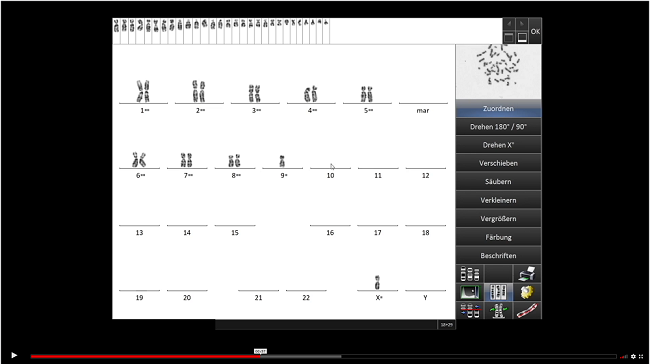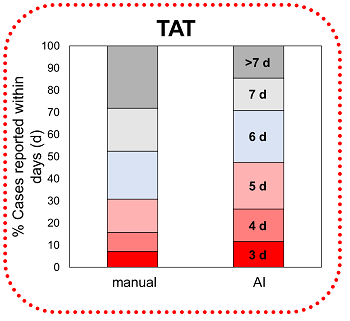Chromosome Analysis 5.0 – Automation, Digitization and Artificial Intelligence
Chromosome analysis is an essential part of the diagnostics of malignant hematological diseases. It plays an important role in confirming the diagnostics, classification, prognosis assessment and therapy planning. The method is considered time-consuming and demanding, both laboratory-wise and in terms of evaluation and reporting. In addition to the continuous expansion of the automation of laboratory processes, the use of artificial intelligence (AI) in chromosome analysis in particular enables a significant reduction in the reporting time as well as a more objective and sensitive assessment of chromosomal changes.
The method
Chromosome analysis is considered a labor-intensive and demanding method, the implementation and interpretation of results of which places high demands on the skills of personnel.
Vital cells capable of division are required, which are cultured for one to three days with subsequent preparation of the metaphases and staining of the chromosomes using a specific banding technique. What is known as Giemsa banding gives each chromosome a specific band pattern, which enables the chromosomes to be clearly identified and chromosomal changes to be detected. The metaphases are captured using a computer-based imaging system on the microscope and then digitally processed to create the karyograms. Based on the analysis of at least 20 karyograms, a karyotype formula is derived and a cytogenetic report is generated.
Reduction of the turnaround time by AI
At MLL, automated processes – from fully automated cell processing to metaphase preparation as well as staining, medium, and spotting robots – have been used in the chromosome analysis laboratory for many years and are constantly being further developed. In collaboration with MetaSystems, MLL has also trained DNNs (deep neural networks) for object recognition, quality assessment, and classification of human chromosomes. Since the end of 2019, such AI-based algorithms have been routinely used in chromosome analysis and are under continuous development. A karyogram can now be created fully automatically and manual image processing steps are no longer necessary.
- Time required to create a karyogram manually: approx. two to three minutes
- Time required to generate a karyogram using AI (including subsequent checking by a cytogeneticist): approx. 25 seconds
We have summarized what this looks like in practice for you in a video. Click here to watch the video.

The use of AI has significantly reduced the turnaround time (TAT) in chromosome analysis. Results can now be reported within ≤5 days for almost 50% of cases compared to approximately 30% of cases before the use of AI. Similarly, the proportion of cases with a turnaround time longer than seven days has been reduced from 28% to 15%.

AI-based quality assessment of metaphases also enables broad analysis across different quality levels, ensuring objective assessment of the entire case. In addition, the use of AI facilitates the targeted search for metaphases with aberrant karyotype, which in particular allows for better detection of small aberrant clones.
Relevance for leukemia diagnostics
Even considering the rapid progress in the field of whole genome sequencing, chromosome analysis remains an essential part of the diagnosis of hematologic neoplasias. The relevance of chromosome analysis is demonstrated by the following aspects, among others:
- Cost-effectivenes
- In some cases, the only possibility to detect small clones due to proliferation advantage during cultivation
- Single-cell analysis:
- Distinguish between independent clones, e.g., between clones of a myeloid and concurrent lymphoid disease
- Distinguish between clonal evolution (further development of a clone) and potential secondary hematological disease in an independent clone - Karyotype as an independent prognostic factor in many hematologic neoplasias (e.g., IPSS-R in MDS or complex karyotype in CLL)
- Karyotype in some cases decisive for therapy (e.g., in AML with myelodysplasia-related changes)
Automation and the use of AI have transformed chromosome analysis, which was considered to be a laborious process, into a faster and more sensitive method that remains highly relevant in many hematologic neoplasias. For guidance in which cases a chromosome analysis is indicated, you will find recommendations on our website regarding the range of methodologies for the respective question or suspected diagnosis.
The authors

»You have questions about the article or want more information? Please feel free to send me an e-mail.«
Christina Glashoff
Biotechnologist, M.Sc.
Deputy Head of Chromosome analysis diagnosis
christina.glashoff@mll.com

»You have questions about the article or want more information? Please feel free to send me an e-mail.«
Dr. rer. nat. Isolde Summerer
Biologist, Dipl.
Head of Cytogenetics
Head of Chromosome analysis diagnosis
Deputy Head of FISH diagnosis
isolde.summerer@mll.com